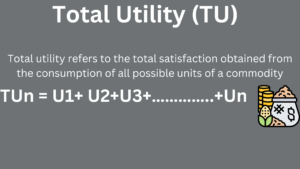| Topic | Total Utility and Marginal Utility |
| Subject | Microeconomics |
| Category | CBSE Economics Class 11 Notes |
Total Utility and Marginal Utility
Utility is the satisfying power of goods ad services. Utility, according to the cardinal utility approach, can be measured in absolute numerical values in terms of utils or they can also be measured in terms of the amount of money the consumer is willing to pay for those goods and services. Let us learn what is meant by Total Utility and Marginal Utility.
Total Utility (TU)
Total utility refers to the total satisfaction obtained from the consumption of all possible units of a commodity. It measures the total satisfaction obtained from the consumption of all the units of that good.
For example, you go to eat a burger. The 1st burger gives you a satisfaction of 50 utils, and the 2nd one gives you a satisfaction of 30 utils, then the total utility, TU from two burgers is 50+30=80 utils. If the 3rd burger generates a satisfaction of 20 utils, the TU from three burgers will be 50+30+20=100 utils.
The total utility derived from the first unit of a commodity is known as initial utility. Total utility is zero at zero level of consumption. TU can be calculated as,
TUn = U1+ U2+U3+…………..+Un
Where,
TUn = Total Utility from n units of a given commodity
U1, U2,U3,…………..,Un = Utility from the 1st, 2nd, 3rd…………nth unit
n = number of units consumed

Marginal Utility (MU)
Marginal utility is the additional utility derived from the consumption of one more unit of the given commodity. It is the utility derived from the last unit of a commodity purchased. Consider the example given before, when the 3rd burger is consumed, TU increases from 80 utils to 100 utils. The additional 20 utils from the 3rd burger is the marginal utility MU. Therefore, marginal utility is the addition made to total utility by consuming one more unit of a commodity. MU can be calculated as,
MUn = TUn – TUn-1
Where,
MUn = Marginal utility from nth unit
TUn = Total utility from n units
TUn-1 = Total utility from n-1 units
n = Number of units of consumption
When the change in units of commodity consumed is more than one, MU can also be calculated as,
MU = Change in TU/ Change in number of Units
MU = ΔTU/ΔQ
Relationship between TU & MU
The total utility, TU increases with the increase in the consumption of a commodity as long as marginal utility MU is positive. In this phase, TU increases but at a diminishing rate because MU from each successive unit tends to diminish. When TU reaches its maximum, MU becomes zero. This is known as point of satiety. The TU curve stops rising at this stage. When the consumption is increased beyond this point, the point of satiety, TU start falling and MU becomes negative. This relationship between TU and MU is depicted by the diagram given above.

Unit 5: Consumer’s Equilibrium and Demand
- Concept of Utility in Economics
- Measurement of Utility in Economics
- Total Utility and Marginal Utility
- Law of Diminishing Marginal Utility
- Conditions of Consumer’s Equilibrium
- Theory of Demand
- What is Demand in Economics
- Demand Characteristics
- Determinants of demand
- Determinants of Market Demand
- Demand Function In Economics
- Demand Schedule | Individual demand schedule | Market demand schedule